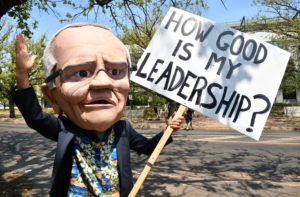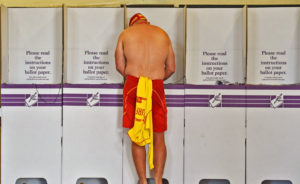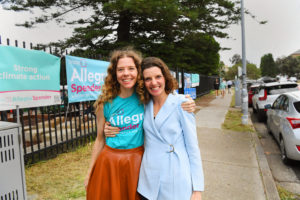On the surface, the triumph of Australian Labor over the Liberal-National Coalition seems like a standard rotation between the same two parties that have alternated in power since the Second World War. Take a closer look, however, and it becomes clear that Australia’s political landscape has undergone a fundamental transformation. The country has finally caught up to the political, social, and cultural crises roiling much of the Western world — a phenomenon aptly dubbed “the end of the end of history”.
Consider some of the basic facts. While narrow victories are not new to Labor — it ran a minority government last time it was in power from 2010 to 2013 — the Coalition has been smashed. With vote counting still ongoing, it is staring down the barrel of losing nearly 20 seats. Its primary vote plummeted by 5.6% since the last election to 35%.
But it is where the seats have been lost that tells the bigger story. At least seven are in the former heartland of the Coalition’s senior partner, the Liberal Party: affluent, inner-city seats in Melbourne, Sydney, and Perth that have reliably voted Liberal since before Scott Morrison was a twinkle in his father’s eye. For example, the Melbourne seat of Kooyong, which former treasurer Josh Frydenberg lost to independent Monique Ryan, was held for 32 years by Australia’s longest serving Prime Minister, Sir Robert Menzies. This is the man who literally founded the Liberal Party in 1944 to promote “the true revival of liberal thought which will work for… the full development of the individual citizen, though not the dull and deadening process of socialism”.
Yet it is not the socialists who triumphed in the leafy boulevards of Kooyong. Indeed, all seven seats have been taken by so-called “teal” independents, committed to traditional liberal values, but disgusted by the Liberal Party’s lack of action on issues such as climate change, corruption and women’s safety. The teals — not incidentally all professional women — would have been members of the Liberal Party in another time, and represented an appealing option to traditional Liberal voters, especially women, fed up with the conservative direction and buffoonish leadership of the Party, under self-proclaimed “bulldozer” Morrison. The few remaining party moderates now fret that these seats may never be won back, even with Morrison gone.
That so many independent candidates succeeded electorally in the context of Australia’s preferential voting system, which strongly tends towards the status-quo, is truly historic. That the Australian Greens, long disdained by Australia’s conservatives and the Murdoch press, are also poised to grab lower-house seats representing some of Brisbane’s most affluent constituencies off the Liberals adds to the astonishment.
Morrison’s impact on the election was not confined to the blue-ribbon heartland. Described as a “psycho” and a “horrible, horrible man” by his own colleagues and as “smirking, unkempt, immature and dishonest” by voters, ScoMo’s time has run out. Relatively unknown when he led the Coalition to a “miracle” victory in 2019, Australian voters have spent the last three years getting to know all about their Prime Minister’s shortcomings: his rabid tribalism, his clownish stunts, his tin ear on social issues like women’s safety, and most importantly his aversion to responsibility when it came to addressing challenges like climate change, the Covid-19 vaccine roll out, disaster preparedness, or stagnating wages.
Even his leadership of the country during the pandemic, highlighted by some commentators as a key achievement, didn’t amount to much. Contrary to hot takes on social media, Morrison did not lose the election because he supported lockdowns and closed borders; rather he was punished most drastically in those states, such as Western Australia and Victoria, where he attacked the state Premiers for their popular Zero Covid policies. The electoral map of Melbourne, for example, now resembles a red wall that the British Labour Party would kill for. WA voters could never forgive Morrison’s support for billionaire Clive Palmer’s legal challenge to Premier McGowan’s hard border policy, or his quip that they should stop hiding in their cave like The Croods and reconnect with the rest of the country.
Yet the Liberal Party’s woes do not mean that the ALP will enjoy smooth sailing. Its strategy of fighting the election with a policy-lite agenda and a focus on Morrison’s character and incompetence will likely suffice to scrape through a small majority when the counting is done. But governing will not be easy, for some of the same reasons that hammered the Liberal Party’s vote: most Australians appear to have had enough of the major parties.
For one, even if it does win an outright majority in the lower house, the ALP will have to contend with coterie of Greens and independents on the Senate crossbench to pass legislation through the upper house, setting up endless fights over its levels of ambition, especially on climate change. This will prove especially challenging as the country confronts myriad problems: a cost-of-living crisis, skyrocketing house prices and massive household debt levels, stagnating wages, an uncertain global geopolitical environment. Then there is climate change, which the election revealed to a top priority for many voters. This is perhaps not so surprising, as Australia’s eastern seaboard is seemingly alternating between fire and flood these days. But the ALP lacks a coherent policy agenda to address these issues, or a strong mandate to implement ambitious responses. Indeed, its share of the vote was even lower than the Coalition’s. At 32%, the ALP’s primary vote is the lowest-ever in the postwar period for a party to form government. This vote-share only translated into an election victory thanks to the magic of Australia’s preferential voting system.
This points to a deeper issue, too. Labor will now confront the same dilemmas that other social democratic parties have faced around the world for some time. The original Third Way innovator in the Eighties, the ALP will have to reap what it helped sow: an atomised society, divided by a growing income, wealth, and cultural gap between a stagnating working class and professional and progressive middle classes; a deindustrialised economy reliant on primary commodity exports and a financialised housing bubble; and widespread lack of trust and faith in democracy, at least in the major parties.
The ALP confronts this context without strong organic links to society. The unions now account for a marginal part of the workforce, while many NGOs and civil society groups are professional outfits with a narrow social base. In this context, the government will find it difficult to unite its various constituencies behind an ambitious policy agenda to tackle Australia’s various challenges.
If experiences elsewhere are anything to go by, the likely outcome is disappointment followed by disillusion, as Labor fails to respond seriously to issues that matter to these voters, and resorts to symbolic and performative gestures to maintain an illusion of governance. As Joe Biden’s Democrats are currently finding out, this is not a sustainable basis for governing. The professional middle classes — whether in the ALP, the Greens, or the ‘teal’ independents — won the latest round. There are no guarantees, however, that their gains would be sustained against the impact of the strong economic headwinds facing Australia.
Meanwhile, the Liberal Party, having lost its silvertail supporters and nearly all its small-l liberal parliamentarians, seems destined to travel another familiar route — towards Trump-lite populism and further to the Right. It is hard to see how the party could win back its old base, something which the majority among the remaining parliamentary cohort seems both incapable and disinterested in achieving.
Instead, the Party, likely under the leadership of ultra-conservative former Defence Minister Peter Dutton, has already indicated that it sees its pathway to victory via Labor’s historic heartland — blue-collar, lower-paid electorates on the outskirts of Australia’s major cities. Few doubt that the cost-of-living crisis and rising interest rates will have a worse impact on these communities. Rising petrol prices also bite hard when people rely on motor vehicles for long commutes. But whether the Liberals succeed in their new strategy, and whether these constituencies, combined with the Nationals’ support in the bush, would be enough to win elections remains to be seen.
One thing is certain, though. Australia’s antipodean exceptionalism is gone. No more will Australia be a relic of “end of history” stable politics, amid the wider crisis engulfing western democracies. Although its preferential voting system somewhat blunts the transition, the 2022 election results clearly show that the end of the end of history has finally arrived in Australia.
Disclaimer
Some of the posts we share are controversial and we do not necessarily agree with them in the whole extend. Sometimes we agree with the content or part of it but we do not agree with the narration or language. Nevertheless we find them somehow interesting, valuable and/or informative or we share them, because we strongly believe in freedom of speech, free press and journalism. We strongly encourage you to have a critical approach to all the content, do your own research and analysis to build your own opinion.
We would be glad to have your feedback.
Source: UnHerd Read the original article here: https://unherd.com





